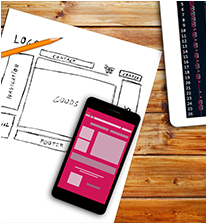
When it’s time to update your website, you have a lot of options. The majority of website owners would be ecstatic at the prospect of a complete visual makeover in accordance with contemporary web design trends, but a new frontend does not automatically imply an improved user experience. It is critical to conduct thorough research into the functionality of your website and which areas should be revised or perhaps even supplemented with new features to improve the user experience so as to maximize conversion rates.
Here are 10 ideas for improving your website’s design and functionality in order to maximize its online potential.
Think about it: Do you really need a website redesign?
Before you decide to overhaul your website, be sure you have a strong reason for doing so. Changing the status of your branding without a compelling reason may have a negative influence on your company.
You should always have a clear purpose for your website redesign. Nowadays it seems that the majority of businesses have a website, even if they do not intend to sell products or services online. If this is your case and there is no intention of using the Internet as a sales channel, then you may want to discard any thoughts about redesigning your site.
Understand your target audience
It is vital to satisfy your target audience’s wants and needs, rather than your own personal preferences, when developing a website. You may conduct research into the different kinds of people who make up your overall user base in order to create personas that represent what your potential customers want to see from your website.

- Identify your target audience
- Research demographics
- Identify behavioral trends
- Utilize social media communities
- Evaluate the competition
In order to appeal to the widest possible audience, you should create personas for your user base and tailor your site to suit a specific set of users.
Build a mobile-responsive website.

Mobile browsing has quickly become the norm as more and more people use tablets and smartphones instead of traditional computers when surfing the web these days. If your website is inaccessible from mobile devices, you can expect to lose a significant portion of potential customers.
You should ensure that your website is accessible and easy to use on any device with a web browser in order to increase the likelihood that it will be found by your target audience and receive more traffic.
Write great content, but keep it brief.
No one wants to read 100-word blog posts when they visit an online news site, yet long copy often seems to be prioritized on corporate sites. You should focus on providing quality over quantity in order to ensure that your writing is effective.
The best content should be easy to read, offers value without plodding, and provide a call-to-action for visitors to complete micro-conversions on the site.
Use KPIs to know your website’s positives and negatives
It’s wonderful to get feedback from coworkers and consumers, but quantitative evidence is even better.
You don’t have to guess what works and what doesn’t when it comes to your site’s design and functionality. By using web analytics, such as click-through rates and time spent on the site, you can see how users interact with your website. Metrics such as:
- Web traffic
- Bounce rate
- Form fills
- Sales
- Conversion rate
- SEO rankings
will not only confirm what you think about your site, but help you identify the areas that require improvement. Fixing any flaws early on will save time throughout the rest of the website redesign process, and it will not cause additional difficulties later.
Keep SEO in mind

Designing your site’s content with SEO in mind will help Google discover it, which can lead to an increase in traffic. There are many different techniques and strategies for optimizing your website’s content, but the first step is researching and understanding how search engines work.
Based on what you find out about how Google crawls websites, you can develop attractive content that is focused on keywords. You can also use HTML tags such as meta descriptions and headers within your content to provide more contextual information to Google.
Don’t build a website from scratch if you already have one
If you already own a website, but aren’t satisfied with how it functions or looks, you can always re-design it rather than creating a new site. If your current site was developed using an outdated web design template, for example, this may be a more efficient solution than creating an entirely new one.
The easiest way to improve your existing site is by updating the templates you use. You can also add additional functionality through third-party plugins or by combining new modules with the preexisting design of the original template.
Hire a web design company!

A website design company is an excellent resource for improving your current site, developing a mobile-responsive version, and incorporating new features that will boost traffic and sales. If you do not have the necessary web development skills to build on or improve your website, hiring skilled professionals can help you stay ahead of the competition.
When looking for a web design company, you should ask them about their experience. In addition to asking how long they’ve been in business and what types of clients they typically work with, make sure you inquire about the resources they use for building websites.
By doing your research beforehand, it’s easier to determine which company is a good fit for your business.
Since web design companies often work with other clients simultaneously, you should also ask if the company will be able to devote enough time and attention to your project.
While you may be excited about the potential of re-launching your website, hiring a web design agency that isn’t prepared or doesn’t have adequate resources can lead to plenty of wasted time. You can check the credibility and experience of a web design agency in UK by reading reviews online, checking their portfolio, and looking for awards they’ve won.